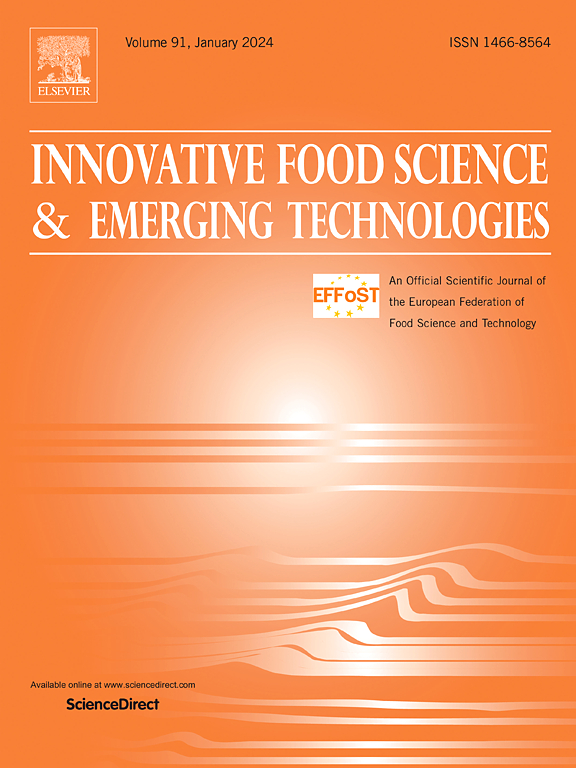添加剂对射频与水浴联合处理鸡胸肉水分变化及食用品质的影响
IF 6.3
1区 农林科学
Q1 FOOD SCIENCE & TECHNOLOGY
Innovative Food Science & Emerging Technologies
Pub Date : 2025-03-20
DOI:10.1016/j.ifset.2025.104009
引用次数: 0
摘要
除热处理外,添加剂的种类和数量也影响肉糜的质量,通过肉糜的水分含量和迁移动力学来评价。经射频(RF)和水浴(WB)联合加热后,由于添加了2.0%的氯化钠,鸡胸肉(MCB)的上表面积累了约10 mm的渗出水,导致蒸煮损失率超过15%,其凝胶性能不符合消费者的质量要求。因此,本研究考察了不同种类和数量的添加剂对低盐(0.5% NaCl) MCB经射频和微波联合加热后水分变化和食用品质的影响。结果表明:添加适量的酵母浸膏和玉米淀粉,可以提高MCB的持水能力,并使样品的蒸煮损失率达到消费者的要求。在0.5% NaCl+ 1.0%酵母浸膏和0.5% NaCl+ 4.0%玉米淀粉处理下,样品的WHC与2.0% NaCl处理组(P >;0.05)。此外,这些处理解决了高盐(2.0% NaCl)样品由于长时间加热导致表面亮度变暗和硬度升高的问题。本研究表明,使用0.5% NaCl+ 1.0%酵母浸膏或0.5% NaCl+ 4.0%玉米淀粉不仅可以减少盐的用量,而且可以保持MCB的品质。这为射频和微波联合加热在鸡肉制品中的更广泛应用提供了理论基础。本文章由计算机程序翻译,如有差异,请以英文原文为准。
Influence of additives on moisture variation and edible quality of minced chicken breast subjected to combined radio frequency and water bath treatments
In addition to heat treatment, the types and quantities of additives also affect the quality of minced meat evaluated by its moisture content and migration dynamics. After combined radio frequency (RF) and water bath (WB) heating, about 10 mm of exuded water accumulated on the upper surface of the minced chicken breast (MCB) due to 2.0 % sodium chloride added, resulting in a cooking loss rate exceeding 15 %, and its gel properties did not meet consumers' quality requirements. Therefore, this study investigated the effects of different types and quantities of additives on the moisture variation and edible quality of low - salt (0.5 % NaCl) MCB after combined RF and WB heating. The results showed that with the addition of appropriate amounts of yeast extract and corn starch, the water-holding capacity (WHC) of MCB were improved, and the cooking loss rates of the samples met consumer demands. Under the conditions of 0.5 % NaCl+1.0 % yeast extract and 0.5 % NaCl+4.0 % corn starch, the WHC of the samples were not significantly different from those of the 2.0 % NaCl group (P > 0.05). Also, these treatments addressed the issues of darkened surface brightness and raised hardness in high-salt (2.0 % NaCl) samples due to prolonged heating. This study demonstrated that the utilization of 0.5 % NaCl+1.0 % yeast extract or 0.5 % NaCl+4.0 % corn starch not only reduced the quantity of salt employed but also maintained the quality of MCB. This provides a theoretical basis for the wider application of combined RF and WB heating in chicken meat products.
求助全文
通过发布文献求助,成功后即可免费获取论文全文。
去求助
来源期刊
CiteScore
12.00
自引率
6.10%
发文量
259
审稿时长
25 days
期刊介绍:
Innovative Food Science and Emerging Technologies (IFSET) aims to provide the highest quality original contributions and few, mainly upon invitation, reviews on and highly innovative developments in food science and emerging food process technologies. The significance of the results either for the science community or for industrial R&D groups must be specified. Papers submitted must be of highest scientific quality and only those advancing current scientific knowledge and understanding or with technical relevance will be considered.

 求助内容:
求助内容: 应助结果提醒方式:
应助结果提醒方式:


